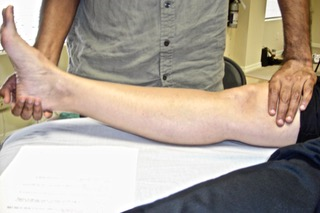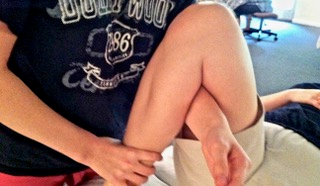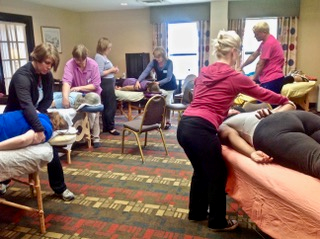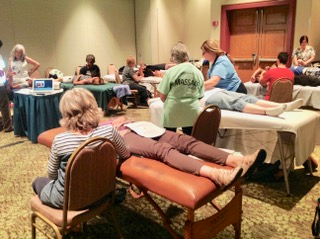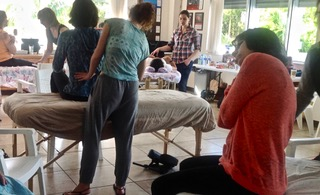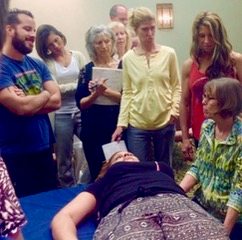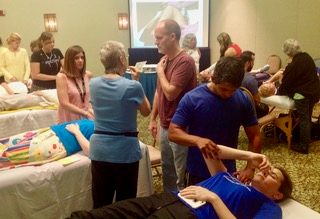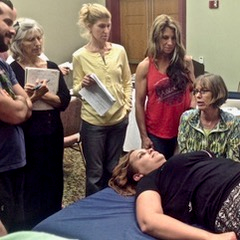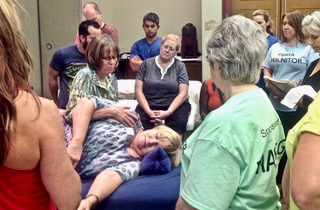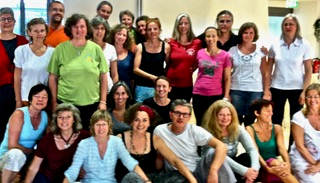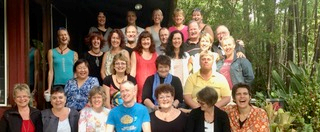Current Schedule
Ethics & Emotions
Online & In Person
St. Augustine, FL
1/10-11, 2026
Pre-requisites: Phase 4.
Instructors: Luann Overmyer LMT MA41092
Time: 9:00 - 6:00 PM
CE Hours: 16 credits FL and NCBTMB
Location: 2825 N 10th St. St. Augustine, FL 32084
Before 12/14/25
$300
After 12/15/26
$350
This class provides a forum for discussion of the practical and legal aspects of professional conduct and practitioner ethics in regards to physical, emotional, and energetic boundaries, clear communication, and client and practitioner expectations. Participants will clarify personal values concerning their work philosophy, and define their scope of practice. We will also discuss techniques designed to contain and guide emotional release and expression so the practitioner and the client are both comfortable and safe. In this class we want to encourage the students to question their assumptions about ethical conduct and engage in dialogue with other practitioners to broaden their understanding of ethical behavior.
This will be a hybrid class! It will be held in person and online.
Please sign up in a timely manner because there is homework to be completed before the class. Once registered you will be sent an extensive questionnaire which must be completed prior to the class as your responses will be used as the basis for class discussion.
Ortho-Bionomy Phase 5 and The Reflexes
Boca Raton, FL
2/28-3/1/2026
Pre-requisites: Phase 4,
Instructors: Luann Overmyer LMT MA41092
Time: Saturday and Sunday 9:00 - 6:00pm
CE Hours: 16 credits FL and NCBTMB
Location: The Therapeutic Alternative. 301 Camino Gardens Blvd, Suite 100. Boca Raton, FL 33432
Before 2/7
$300
After 2/8
$345
Phase 5 Ortho-Bionomy is about having a conversation with the tissue.
The focus of Phase Five is to move to a more subtle level of awareness of the practice and principle of Ortho-Bionomy®. Specific techniques develop and increase the student's understanding and proprioceptive sensitivity to the self-corrective movements initiated by the client. Through the practice of observing, following and supporting subtle movement patterns, muscular tension is released, range of motion may be increased and pain may be reduced. The gentle and subtle approach of this work is especially appropriate for releasing severe, acute pain and chronic patterning, This class presents practical, gentle release techniques can seem almost magical in their effectiveness. Releases for psoas, pelvis, lumbars, coccyx, neck, shoulders, clavicle, ears, eyes, jaw and more will be presented and practiced.
Clarify your capacity to more clearly track mental, emotional and physical aspects
Observe and work with tissue preferences in relationship to structural alignment
Reinforce the body’s wisdom not the patient’s storylines
Detect mood in the tissue
- Use internal state shifts to influence and interrupt habituated storylines and holding patterns.
Pelvic Stabilization
Dunedin, New Zealand
3/21-22/2026
Pre-requisites: Phase 4,
Instructors: Luann Overmyer LMT MA41092
Time: Saturday and Sunday 9:00 - 6:00pm
CE Hours: 16 credits FL and NCBTMB
Location: Holistic Health Centre 12 Church St. Mosgiel, New Zealand
Before 2/25
$450
After 2/26
$500
The pelvis is the foundation of postural alignment. The pelvis carries, balances and translates the weight of the spine when standing, sitting and walking, and modulates the gait patterns coming from the feet and legs. This balance is achieved through the flexibility of the lumbar spine, the stability of the 5th lumbar and sacrum connection, and a dynamic movement balance at the illio-sacral joint.
This class presents the Ortho-Bionomy approach to evaluating and stabilizing the pelvis. Protocols for assessment and positional release techniques for re-establishing balance in the pelvis will be presented and practiced. Phase 4 is a prerequisite and a Phase 5 class is recommended.
Ortho-Bionomy Study Day
Dunedin, New Zealand
3/23/2026
Pre-requisites: Phase 4,
Instructors: Luann Overmyer LMT MA41092
Time: Monday 10-4pm
CE Hours: 6 credits FL and NCBTMB
Location: Holistic Health Centre 12 Church St. Mosgiel, New Zealand
Before 2/25
$220
After 2/26
$275
Bring your questions and your body. This class offers an opportunity to observe and discuss the whys, the hows, and wherefores of a session, receive a session, and have your questions about structuring a session answered. 3 hours of study group in the morning with observed sessions and discussion in the afternoon. Credit toward study group, consultations, and session received.
Ortho-Bionomy Self Care
Dunedin, New Zealand
3/25/2026
Pre-requisites: None
Instructors: Luann Overmyer LMT MA41092
Time: Monday 9-5pm
CE Hours: 8 credits FL and NCBTMB
Location: Holistic Health Centre 12 Church St. Mosgiel, New Zealand
Before 2/25
$220
After 2/26
$275
Through the practice of Self Care we discover the self-corrective capacity of our bodies and empower ourselves in the process of self-healing and well-being. In this class we will take time to slow down and listen to the body’s responses. By noticing your sensations and discriminating between more or less comfortable, the body learns to choose comfort and move with ease.
Learn to adapt the techniques of Ortho-Bionomy to relieve pain and tension in your own body. Self-Care addresses chronic aches and pains as well as ways to work with injuries. This class is appropriate for anyone wanting to explore comfort, and also for health care practitioners looking for specific exercises to give clients.
Learn to:
- Relieve pain and tension with positional release.
- Create new patterns of pain-free movement.
- Increase flexibility and range of motion with isometric and isotonic exercises.
- Strengthen muscle tone through isotonic exercises.
- Improve posture for relief of strain and stress.
- Discover the ways your body uses positions and movement to reclaim comfort and well-being.
Ortho-Bionomy Phase 4
Invercargill, New Zealand
3/28-29/2026
Pre-requisites: None
Instructors: Luann Overmyer LMT MA41092
Time: Monday 9-5:30pm
CE Hours: 16 credits FL and NCBTMB
Location: 97 B Yarrow St. Invercargill, 9810 New Zealand
Before 2/20
$450
After 2/21
$500
This foundational class covers the history and principles of Ortho-Bionomy and specific positioning techniques to stimulate natural self-correcting neuro-muscular reflexes for all parts of the body. These techniques facilitate the release of pain and tension patterns, promote expanded range of motion, and offer a greater sense of well-being. This work is easy to learn, easy on your body, highly effective, and combines well with any system of health care.
Learn non-invasive, indirect, gentle releases for the
- Psoas and Quadratus Lumborum Muscles
- Cervical, Thoracic, and Lumbar Spine
- Ribs, Shoulders, Elbows and Wrists
- Knees, Ankles and Feet
Work more effectively with bones, joints, structure, whiplash, posture, scoliosis, reflexes and more
- Build Assessment Skills
- Enhance the client’s self healing ability
- Gentle on both client and practitioner
- Easy to Learn, Practical, Hands on Classes
Ortho-Bionomy Phase 5 and The Reflexes
Melbourne, Australia
4/11-12, 2026
Pre-requisites: Phase 4,
Instructors: Luann Overmyer LMT MA41092, Janine McCarthy
Time: Saturday and Sunday 9:00 - 6:00pm
CE Hours: 16 credits FL and NCBTMB
Location: Canterbury Neighborhood Centre 2 Kendall St. Canterbury, victoria, Australia 3126
Before 3/22
$400
After 3/23
$450
Phase 5 Ortho-Bionomy is about having a conversation with the tissue.
The focus of Phase Five is to move to a more subtle level of awareness of the practice and principle of Ortho-Bionomy®. Specific techniques develop and increase the student's understanding and proprioceptive sensitivity to the self-corrective movements initiated by the client. Through the practice of observing, following and supporting subtle movement patterns, muscular tension is released, range of motion may be increased and pain may be reduced. The gentle and subtle approach of this work is especially appropriate for releasing severe, acute pain and chronic patterning, This class presents practical, gentle release techniques can seem almost magical in their effectiveness. Releases for psoas, pelvis, lumbars, coccyx, neck, shoulders, clavicle, ears, eyes, jaw and more will be presented and practiced.
Clarify your capacity to more clearly track mental, emotional and physical aspects
Observe and work with tissue preferences in relationship to structural alignment
Reinforce the body’s wisdom not the patient’s storylines
Detect mood in the tissue
- Use internal state shifts to influence and interrupt habituated storylines and holding patterns.
Ortho-Bionomy Cranial
Melbourne, Australia
4/17-19/2026
Pre-requisites: Phase 4, 5, 6
Instructors: Luann Overmyer LMT MA41092
Time: Friday, Saturday and Sunday 9:00 - 6:00pm
CE Hours: 24 credits FL and NCBTMB
Location: Canterbury Neighborhood Centre 2 Kendall St. Canterbury, victoria, Australia 3126
Before 4/1
$600
After 4/2
$675
This approach to cranial work blends Ortho-Bionomy‘s osteopathic roots with Arthur Pauls’ energetic / esoteric philosophy of the work. The subtle contact characteristic of cranial-sacral work fits perfectly into the spectrum of Ortho-Bionomy practice. In Ortho-Bionomy we work with the self-balancing and natural corrective reflexes of the organism. We approach the person as a whole being. We acknowledge in a very direct way the body structure in Phase 4, the internal fluid movement in Phase 5, the energy in Phase 6, and the spirit in Phase 7. In cranial work we are meeting and contacting the subtlest interface between body, fluids, energy and spirit as we observe how the person’s own self corrective capacity interacts to resolve physical and energetic misunderstandings and return the system to balanced physiologic motion.
Ortho-Bionomy Phase 5 and The Reflexes
Sunshine Coast, Australia
4/25-26/2026
Pre-requisites: Phase 4,
Instructors: Luann Overmyer LMT MA41092, Rob Rich
Time: Saturday and Sunday 9:00 - 6:00pm
CE Hours: 16 credits FL and NCBTMB
Location: CWA Hall 11 Steven St. Yandina, Australia
Before 4/1
$400
After 4/2
$440
Phase 5 Ortho-Bionomy is about having a conversation with the tissue.
The focus of Phase Five is to move to a more subtle level of awareness of the practice and principle of Ortho-Bionomy®. Specific techniques develop and increase the student's understanding and proprioceptive sensitivity to the self-corrective movements initiated by the client. Through the practice of observing, following and supporting subtle movement patterns, muscular tension is released, range of motion may be increased and pain may be reduced. The gentle and subtle approach of this work is especially appropriate for releasing severe, acute pain and chronic patterning, This class presents practical, gentle release techniques can seem almost magical in their effectiveness. Releases for psoas, pelvis, lumbars, coccyx, neck, shoulders, clavicle, ears, eyes, jaw and more will be presented and practiced.
Clarify your capacity to more clearly track mental, emotional and physical aspects
Observe and work with tissue preferences in relationship to structural alignment
Reinforce the body’s wisdom not the patient’s storylines
Detect mood in the tissue
- Use internal state shifts to influence and interrupt habituated storylines and holding patterns.
Ortho-Bionomy Phase 6
Hervey Bay, Australia
5/2-3/2026
Pre-requisites: Phase 4, 5
Instructors: Luann Overmyer LMT MA41092, Karen Somter
Time: Saturday and Sunday 9:00 - 6:00pm
CE Hours: 16 credits FL and NCBTMB
Location: Ortho-Bionomy on the Frasier Coast Suite 6 Pialba Professional Centre 40 Torquay Rd. Pialba, QLD Australia 4655
Before 4/4
$400
After 4/5
$450
This class heightens our sensitivity and awareness to energetic relationship. The techniques clarify the effects of interactions within the auric field that promote a natural return to physical, mental and emotional well-being. Students learn to notice and identify energetic shifts within themselves and others, and to model that capacity. They learn the value of "not doing" as the practitioner steps back to allow the client's self-healing capacities to engage. The concepts of alignment and attunement, holding space, interrupting patterns, and offering options will be explored as they relate to the natural reflexive responses of rebound, recoil, remembered emotional response, follow on response, and ongoing action.
Ortho-Bionomy Residential
Hervey Bay, Australia
5/10-16, 2026
Pre-requisites: Phase 4., 5, 6
Instructors: Luann Overmyer LMT MA41092
Time: TBD
CE Hours: 40 credits FL and NCBTMB
Location: Sanctuary Lakes
Before 12/31/25
$1500
After 1/1/26
$1800
Immerse yourself in the dance and flow of Ortho-Bionomy, and deepen your understanding of Ortho-Bionomy principles and practice in a week long Residential experience. Residential trainings provide participants with the opportunity to broaden and deepen their understanding of Ortho-Bionomy techniques and principles through five days of uninterrupted study. Residentials allow time for learning and personal growth as well as relaxation to facilitate the integration of technique and the qualities of "BEing" rather than "Doing".
Ortho-Bionomy Phase 6
Boca Raton, FL
6/27-28/2026
Pre-requisites: Phase 4, 5
Instructors: Luann Overmyer LMT MA41092
Time: Saturday and Sunday 9:00 - 6:00pm
CE Hours: 16 credits FL and NCBTMB
Location: The Therapeutic Alternative. 301 Camino Gardens Blvd, Suite 100. Boca Raton, FL 33432
Before 2/7
$300
After 2/8
$345
This class heightens our sensitivity and awareness to energetic relationship. The techniques clarify the effects of interactions within the auric field that promote a natural return to physical, mental and emotional well-being. Students learn to notice and identify energetic shifts within themselves and others, and to model that capacity. They learn the value of "not doing" as the practitioner steps back to allow the client's self-healing capacities to engage. The concepts of alignment and attunement, holding space, interrupting patterns, and offering options will be explored as they relate to the natural reflexive responses of rebound, recoil, remembered emotional response, follow on response, and ongoing action.
Ortho-Bionomy Self Care
Through the practice of Self Care we discover the self-corrective capacity of our bodies and empower ourselves in the process of self-healing and well-being. In this class we will take time to slow down and listen to the body’s responses. By noticing your sensations and discriminating between more or less comfortable, the body learns to choose comfort and move with ease.
Learn to adapt the techniques of Ortho-Bionomy to relieve pain and tension in your own body. Self-Care addresses chronic aches and pains as well as ways to work with injuries. This class is appropriate for anyone wanting to explore comfort, and also for health care practitioners looking for specific exercises to give clients.
Learn to:
- Relieve pain and tension with positional release.
- Create new patterns of pain-free movement.
- Increase flexibility and range of motion with isometric and isotonic exercises.
- Strengthen muscle tone through isotonic exercises.
- Improve posture for relief of strain and stress.
- Discover the ways your body uses positions and movement to reclaim comfort and well-being.
- Refine your subtle palpatory listening skills
- Clarify your capacity to more clearly track mental, emotional and physical aspects
- Observe and work with tissue preferences in relationship to structural alignment
- Reinforce the body’s wisdom not the patient’s storylines
- Detect mood in the tissue
- Use internal state shifts to influence and interrupt habituated storylines and holding patterns.
Introduction to Bones For Life
Experience this easy to learn modality to encourage dynamic postural alignment, bone strengthening, and proportional flexibility. Clarify optimal relationships between the 3 primary spinal curves through gentle movement processes that explore functional gravitational impact on structure.
Advanced Phase 4 Study Group
This study group is a follow up only for folks who have recently taken the Advanced Phase 4 class.
- Psoas and Quadratus Lumborum Muscles
- Cervical, Thoracic, and Lumbar Spine
- Ribs, Shoulders, Elbows and Wrists
- Knees, Ankles and Feet
- Build Assessment Skills
- Enhance the client’s self healing ability
- Gentle on both client and practitioner
- Easy to Learn, Practical, Hands on Classes

